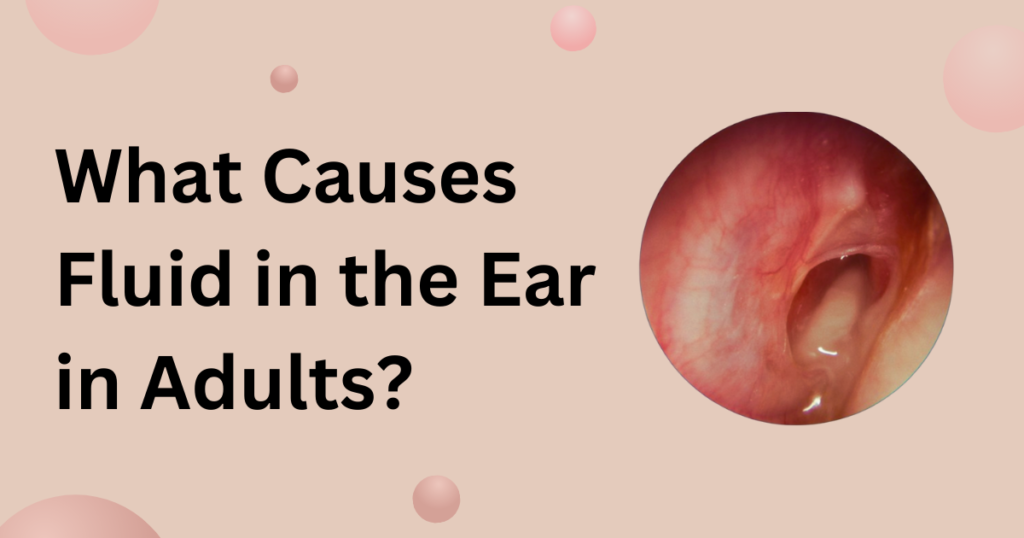Fluid in the ear can be an uncomfortable and sometimes painful experience for adults. Many people associate this issue with children, but it can affect adults too. In this article, we’ll explore what causes fluid in the ear in adults, how to identify the symptoms , and potential treatment options. Whether you’re dealing with occasional discomfort or chronic issues, understanding the root causes is essential for effective treatment.
Causes of Fluid in the Ear in Adults
Fluid in the ear in adults can be caused by a variety of factors, ranging from mild to severe. Some frequent triggers of fluid in the ear are:
1. Eustachian Tube Dysfunction
The Eustachian tube, which links the middle ear to the back of the nasal passage, plays a key role in fluid drainage. When this tube becomes blocked or doesn’t function properly, fluid can build up in the middle ear. This is one of the most common causes of fluid in the ear in adults. Allergies, sinus infections, or even changes in altitude can lead to Eustachian tube dysfunction.
2. Ear Infections
Ear infections are another significant cause of fluid buildup in adults. Bacterial or viral infections can lead to inflammation, causing fluid to accumulate behind the eardrum. This is often accompanied by pain, swelling, and even temporary hearing loss.
3. Allergies
For some adults, allergies are a major contributor to fluid in the ear. Allergens like pollen, dust, or pet dander can cause inflammation in the nasal passages and Eustachian tubes, preventing fluid from draining effectively. This can result in discomfort and pressure in the ear.
4. Sinus Infections
Sinus infections can also cause fluid buildup in the ear. When the sinuses become inflamed, they can block the drainage of fluid from the Eustachian tube, leading to fluid retention in the middle ear.
5. Barotrauma
Barotrauma occurs when there is a sudden change in pressure, such as when flying, diving, or driving through mountains. If the pressure isn’t equalized, it can cause fluid to build up in the ear. This is especially common in people who have issues with their Eustachian tubes.
Symptoms of Fluid in the Ear in Adults
Recognizing the symptoms of fluid in the ear is crucial for early treatment. Common symptoms include:
- Ear Pain: Discomfort or a feeling of fullness in the ear is often a sign of fluid buildup.
- Hearing Loss: Fluid in the ear can cause temporary hearing loss or a muffled sensation.
- Tinnitus: Ringing or buzzing in the ear may occur when fluid is present.
- Balance Issues: Since the ear is responsible for balance, fluid buildup can lead to dizziness or unsteadiness.
How to Treat Fluid in the Ear in Adults
Treating fluid in the ear depends on the underlying cause. Here are some common treatments:
1. Over-the-Counter Decongestants
Decongestants can help reduce swelling in the Eustachian tubes, allowing fluid to drain more easily. This is especially useful for fluid buildup caused by colds or allergies.
2. Antihistamines
If allergies are the culprit, antihistamines can help reduce inflammation and prevent fluid buildup in the ear. These medications can be taken orally or as a nasal spray.
3. Ear Tubes
In more severe or chronic cases, doctors may recommend the insertion of ear tubes to allow fluid to drain. This is a common treatment for those with recurring ear infections or persistent fluid buildup.
4. Home Remedies
For mild cases, home remedies such as warm compresses or steam inhalation can help relieve symptoms and promote drainage of fluid from the ear.
Understanding what causes fluid in the ear in adults is the first step to finding relief. From Eustachian tube dysfunction to ear infections and allergies, the reasons vary, but treatment options are available. If you’re experiencing fluid in your ear, consult a healthcare professional to determine the best course of action.
Don’t let discomfort linger—seek treatment and get back to feeling your best!



